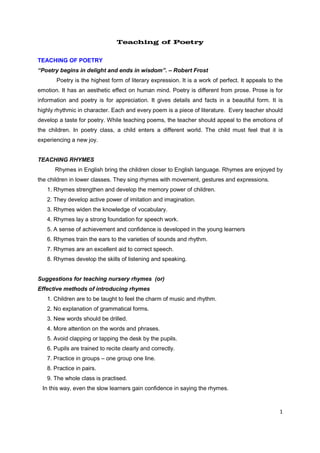
1 7 teaching-of-poetry
- 1. Teaching of Poetry 1 TEACHING OF POETRY “Poetry begins in delight and ends in wisdom”. – Robert Frost Poetry is the highest form of literary expression. It is a work of perfect. It appeals to the emotion. It has an aesthetic effect on human mind. Poetry is different from prose. Prose is for information and poetry is for appreciation. It gives details and facts in a beautiful form. It is highly rhythmic in character. Each and every poem is a piece of literature. Every teacher should develop a taste for poetry. While teaching poems, the teacher should appeal to the emotions of the children. In poetry class, a child enters a different world. The child must feel that it is experiencing a new joy. TEACHING RHYMES Rhymes in English bring the children closer to English language. Rhymes are enjoyed by the children in lower classes. They sing rhymes with movement, gestures and expressions. 1. Rhymes strengthen and develop the memory power of children. 2. They develop active power of imitation and imagination. 3. Rhymes widen the knowledge of vocabulary. 4. Rhymes lay a strong foundation for speech work. 5. A sense of achievement and confidence is developed in the young learners 6. Rhymes train the ears to the varieties of sounds and rhythm. 7. Rhymes are an excellent aid to correct speech. 8. Rhymes develop the skills of listening and speaking. Suggestions for teaching nursery rhymes (or) Effective methods of introducing rhymes 1. Children are to be taught to feel the charm of music and rhythm. 2. No explanation of grammatical forms. 3. New words should be drilled. 4. More attention on the words and phrases. 5. Avoid clapping or tapping the desk by the pupils. 6. Pupils are trained to recite clearly and correctly. 7. Practice in groups – one group one line. 8. Practice in pairs. 9. The whole class is practised. In this way, even the slow learners gain confidence in saying the rhymes.
- 2. Teaching of Poetry 2 DONT’s 1. Do not sing the rhyme to begin with. 2. Do not ask individuals to say the rhyme in the beginning. 3. Do not teach any morals. 4. Do not read out the rhyme from the book. 5. Memorise and say the rhyme for correct pronunciation, gestures and voice modulation. 6. Repeat the rhyme everyday for a short time. POEMS “Poetry is the spontaneous overflow of feelings and emotions in tranquility” William Wordsworth “Poetry should reach the heart of the reader because it emerges from the heart of the poet”. Poetry is meant for enjoyment and pleasure. It appeals to our senses. In poetry, rhythm is a universal phenomenon. The regular rhythm of poetry appeals to the child. It draws the child more close to the language. It develops the child’s imagination. Poetry is not to be taught. It is to be introduced as an activity because it gives pleasure to the children. This activity is connected with the learning and appreciation of poetry in the curriculum. It is not a mere soulless repetition of the poem. The chief focus is to help the students appreciate and enjoy the poem. This leads them to memorization of the poem. It is difficult to arouse enthusiasm among the pupils, if the teacher does not read, listen to and enjoy good poems by himself. Poetry appeals to the ears more than the eyes. Rhyme and rhythm play a dominant role in poetry and so it is meant to be read aloud otherwise the effect is lost. Rhymes and songs help fluency in English. Elucidation by questioning brings the poem or poet closer to the pupils. A few more suggestions for teaching a poem : 1. The message of a poem is more important than the details. 2. The main theme of the poem is to be grasped (understood). 3. Explanation and paraphrasing does not create any enthusiasm. 4. The teacher should present the poem orally with correct pronunciation and rhythm. 5. Students concentrate all their attention in listening if the poem is read aloud. 6. Verbal peculiarities should be neglected.
- 3. Teaching of Poetry 3 7. Students’ appreciation and understanding of the poem and poet’s experience can be expressed in the form of drawing. 8. Encourage pupils to do activities at the end of the class. The Process of Teaching a Poem There are 3 main stages in the process of teaching a poem. They are as follows: 1. Preparation 2. Presentation 3. Discussion Preparation : 1. The main outline of the poem is to be understood by the students by equipping them. 2. Familiarise the students with important words and expressions 3. Ensure that the ideas of the poem are reachable and comprehensible by the students. 4. This can be done by getting responses through simple questions by the teacher. Presentation : The teacher reads the poem or recites with proper pronunciation, intonation, gestures and facial expressions. If necessary this can be repeated by the teacher. Discussion : The teacher need not explain every word or every line of the poem. Simple questions may be asked to ensure their understanding of the poem. The teacher uses pictures to explain the meaning of difficult words. The teacher can pose questions to the class to get meanings for difficult words. Conclusion : 1. Preparation is equipping the students for quick understanding. 2. Presentation involves reading, re-reading, elucidation of answers, kindling interest and calling for intense concentration on the words, rhymes, rhythm, imagery etc., in the poem. 3. Discussion leads the pupils to a thorough knowledge of the poem.